Invented by William Bardosh, Ryan Richard McKenzie, Tizazu Mekonnen, Manoj Gokul Nerkar, Misha Miazga-Rodriguez, Terraverdae Bioworks Inc
The market for biopolymer films and coatings is expected to grow significantly in the coming years. According to a report by MarketsandMarkets, the global biopolymer films market is projected to reach USD 10.8 billion by 2025, growing at a CAGR of 7.5% from 2020 to 2025. The demand for biopolymer films is driven by the increasing awareness about environmental issues and the need for sustainable packaging solutions.
Biopolymer films and coatings are used in a variety of applications such as food packaging, agriculture, and medical devices. In the food industry, biopolymer films are used to extend the shelf life of products and prevent spoilage. They are also used as a barrier against moisture, oxygen, and other gases, which helps to maintain the freshness and quality of food products.
In agriculture, biopolymer films are used to protect crops from pests and diseases. They are also used as mulch films to improve soil quality and conserve water. Biopolymer coatings are used to improve the durability and performance of agricultural equipment.
In the medical industry, biopolymer films and coatings are used in the production of medical devices such as wound dressings, surgical gloves, and implants. They are also used in drug delivery systems and tissue engineering.
Bioactive biopolymer films are a new and emerging area of research. These films are designed to have specific biological properties such as antimicrobial, antioxidant, and anti-inflammatory properties. They are used in a variety of applications such as food packaging, cosmetics, and medical devices.
The market for bioactive biopolymer films is expected to grow significantly in the coming years. According to a report by Grand View Research, the global bioactive biopolymer films market is projected to reach USD 1.2 billion by 2025, growing at a CAGR of 7.8% from 2020 to 2025. The demand for bioactive biopolymer films is driven by the increasing demand for natural and organic products and the growing awareness about the health benefits of bioactive compounds.
In conclusion, the market for biopolymer films, coatings, and bioactive biopolymer films is growing rapidly due to the increasing demand for sustainable and eco-friendly materials. These materials are used in a variety of applications such as food packaging, agriculture, and medical devices. The demand for bioactive biopolymer films is also growing due to the increasing demand for natural and organic products. As the world becomes more environmentally conscious, the demand for biopolymer films and coatings is expected to continue to grow in the coming years.
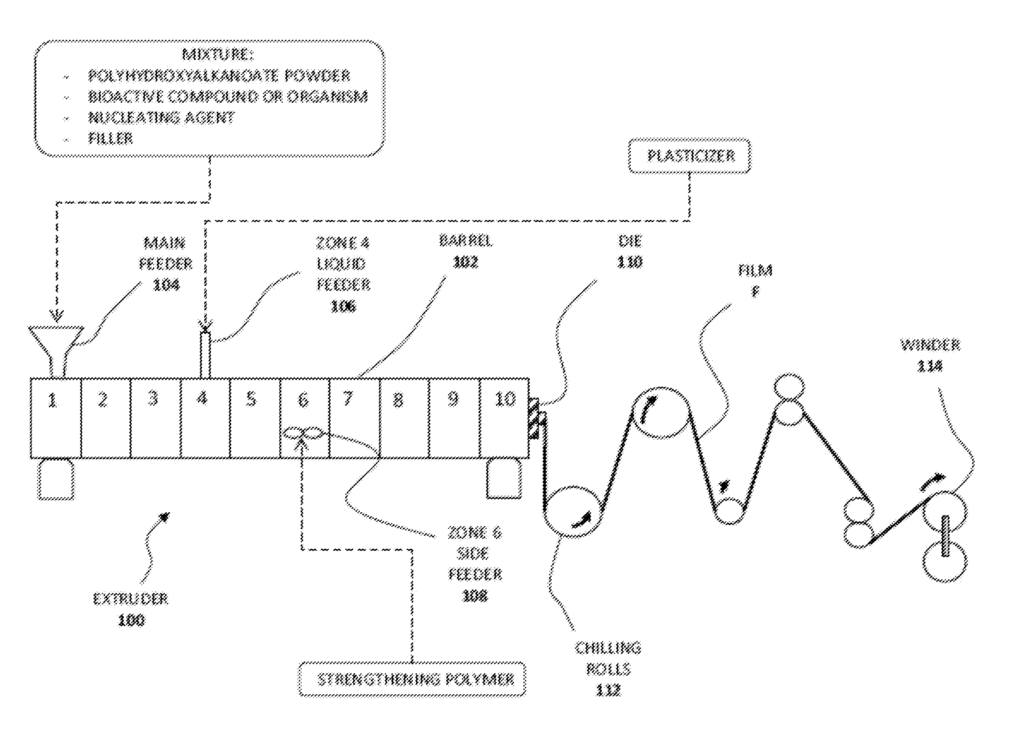
The Terraverdae Bioworks Inc invention works as follows
A multilayer bioactive film.” The multi-layer film includes one or more bioactive compounds or microorganisms for promoting growth and health of a plant, the bioactive compounds or microorganisms contained between layers of the film, wherein each one of the layers comprises about 60% to about 75% (m/m) polyhydroxyalkanoate. The bioactive microorganisms or compounds may be any combination of the following: a metabolite (a chemical that is anti-microbial), an enzyme, live microorganisms, a herbicide, pesticide, or plant growth hormone. The release of one or several bioactive compounds can be controlled and timed.
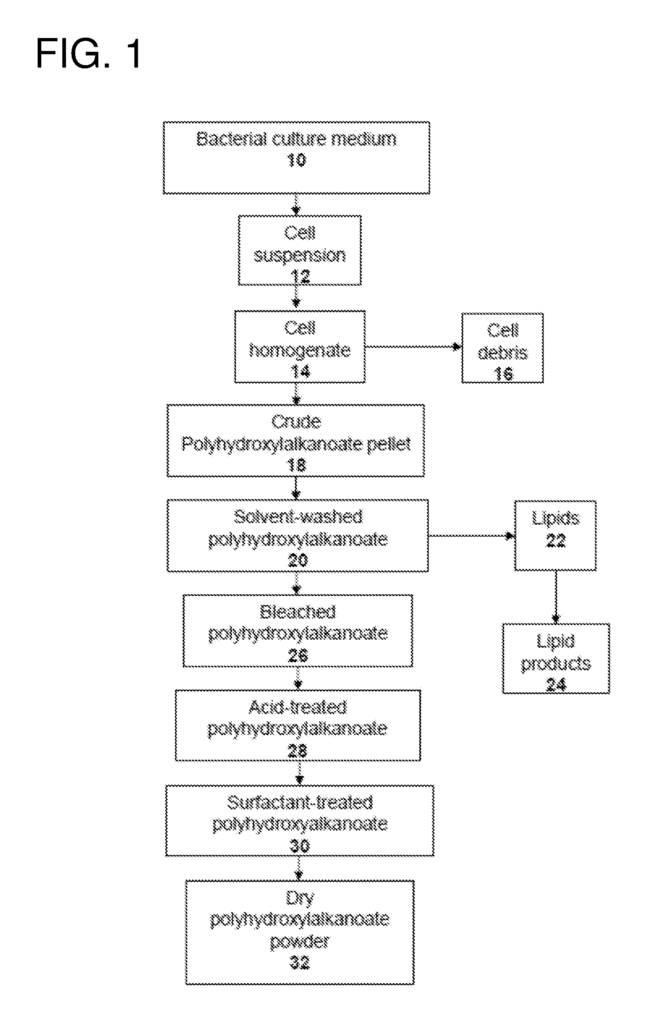
Background for Biopolymer films, coatings and bioactive biopolymer films
Plastic films and coatings can be used in a variety of ways. Plastic films and coatings can be used for a variety of purposes, including food packaging, as liners in industrial packaging, shopping bags and garbage bags. Other uses include agricultural films, construction film, photographic films, magnetic audio and video recordings films, and x-ray films.
Plasticulture is the use of plastics for agricultural purposes. It has been around since the beginnings of agriculture. Plasticulture is used in many ways, including silage bags, greenhouse films, and plastic mulch. Plastic mulch is widely used by farmers all over the world to improve crop quality and yield. Grandview Research, a consultancy, projected in 2013 that the mulch film segment would account for 44.3% market volume of the $5.9 billion market for agricultural films. This market is expected to grow at 7.8% annually through 2020.
Silage wrap films (bale wraps) are commonly used in agricultural applications. Silage films, which are usually ductile and sticky films used to wrap tightly bales of fresh grass or wilting Grass. Forage is usually baled using a fixed chambered baler to produce uniformly-sized bales. These can be wrapped in silage film with a bale wrapper or placed into a bag of silage. Ensiling forage in plastic is a common practice, especially among the dairy industry. This practice allows for high-quality feed to be stored at a low cost. The silage wrap is used to protect forage material between the time it is cut and the time when it will be used as animal feed. In practice, plastics used to wrap the silage should have excellent oxygen and moisture barrier properties. “Sealing silage in a plastic film creates a stale environment that encourages anaerobic fermentation, which results in the breakdown of complex carbohydrates into sugars more easily digestible by animals.
Plastic mulching is another common application of plastic films. The agricultural plastic mulch film consists of a plastic sheet the width of the planting row plus an extra width on either side to pile soil onto. The sheet is rolled along the row of plants and then holes are punched at regular intervals to suit the crop. The plastic mulch films are used all over the world to protect soils from weeds and insects, reduce evaporative losses and reduce fertilizer leakage. Plastic mulch films can be used to manage weeds. They do this by creating a physical barrier over the soil, and blocking sunlight. Plastic mulch can also be used to limit losses caused by drought. It helps crops survive drought stress, by limiting the evaporation of water from soils and blocking the growth weeds which would otherwise draw moisture from the target crop. Climate change and intensive farming practices are causing soil degradation which leads to an increase in yield losses from drought stress.
Mulch film, silage wraps and bags are typically made from linear low density or polypropylene or polyethylene. These plastics have very long polymerized chains and are flexible. These long chains may degrade over time when exposed to UV light or high temperatures. Silage bags and films are available in many colors. Black, blue, and green films are the most common. Incorporating a black pigment, usually carbon black, into silage films or silage bags can limit UV degradation. In northern climates it may be desirable to increase the radial heat of black plastic, since this could improve silage fermentation and prevent silage from freezing, which would make feeding easier during winter. Mulch films come in a wide range of colors. These include black, white and silver films, as well as red, blue, yellow, brown and green. The amount of radiation that can heat the soil under the film and encourage weed growth is determined by the opacity. The film is made of different colors that produce specific temperatures and soil conditions.
Plastic mulches are typically produced from non-biodegradable olefins such as polyethylene or polypropylene, and are generally considered acceptable for organic agriculture under organic standards as long as they are not incorporated into the soil or disposed of in an environmentally-unfriendly manner. The disadvantage of synthetic plastic mulches, however, is that they must be removed once they are in use, which can be a time-consuming process. Disposal costs are also a major expense for the grower.
Oxobiodegradable Mulch Films do not meet international standards of biodegradability or compostability, and are not true Bioplastics.” Oxo-biodegradable films are not acceptable under any organic farming standards. They are not biosourced, and they do not meet the standards of biodegradability or compostability. Therefore they cannot be accepted as biosourced biodegradable mulches. In contrast, while they may be synthetic plastic mulches by organic standards, the mulches must be removed and disposed in an environmentally friendly manner after the growing season. It is known that microplastic fragments persist at high levels in the environment and can be ingested by many organisms and incorporated into their tissues and bodies, where they may cause harm. Oxo-biodegradable film perpetuates, rather than solving, a significant environment problem.
The U.S. Patent describes “Various methods of producing an agricultural mulch film that degrades on the soil.” U.S. Pat. No. Newland, et. al. This document (incorporated by reference herein in its entirety), describes a mulch film which is degradable and is made by mixing a prooxidant with a polyolefin water-soluble film. The result is what is commonly referred to an oxobiodegradable material. Pro-oxidants disclosed include metal acetylacetonates (metal acetylacetonates), metal alkylbenzoylacetates (metal acetylacetonates), metal stearates (metal oleates) and metal acetylacetonates. This process has been refined, as described in a film composition by Cole et. al. (U.S. Pat. No. No. After exposure to heat or sunlight, the pro-oxidant chemicals added to oxobiodegradable materials cause them to break down. Although fragmentation increases the likelihood of plastics being biodegradable, it can still take months or even decades. These films don’t meet international compostability standards such as ASTM D6400 which requires that 60 percent of the carbon in plastics is converted to carbon dioxide within six months.
Starch has been used to produce biodegradable film mulch because it is cheap, abundant, and can be formed into a film. Starch is a naturally occurring polymer. However, biodegradable films based on starch blends are often formulated with synthetic polymers derived from petroleum, such as Polycaprolactone. This makes them unsuitable for organic production, unless they are manually removed at the end the growing season. Starch-based film products are usually coated or blended water-resistant polymers, as starch films lose their strength when they become saturated with moisture. U.S. Pat. No. 3,949,145 to Otey (incorporated herein by reference in entirety), describes a mulch film formulation including starch and a synthetic polyvinyl alcohol that is coated with a water-resistant coating composed of polyol-toluene-diisocyanate prepolymer and 1 part of poly(vinylidene chloride-acrylonitrile) copolymer or 1 part of poly(vinyl chloride) resin containing a plasticizing amount of a suitable plasticizer.
U.S. Pat. No. No.
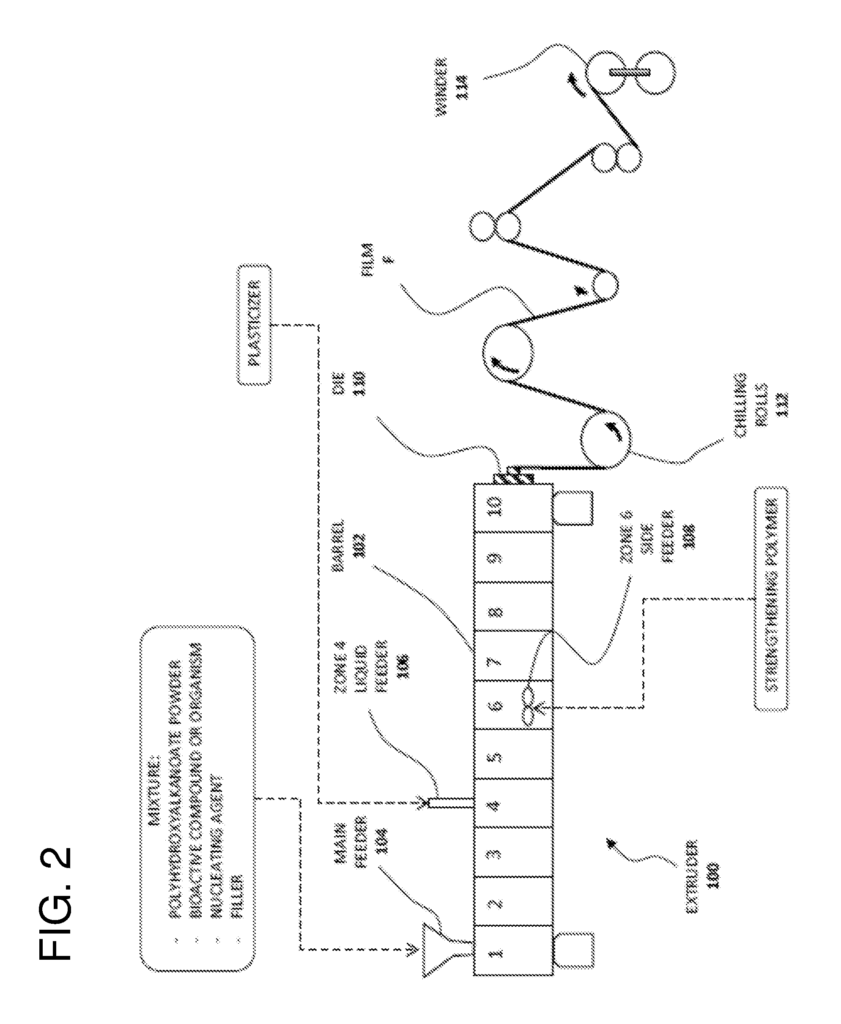
Polyhydroxyalkanoates are biologically degradable polymers which can be accumulated by microorganisms as sources of carbon and energy. Poly(3-hydroxybutyrate) (PHB) and the copolymer poly(3-hydroxybutyrate)-co-valerate (PHB/HV) are the most known and best studied forms of polyhydroxyalkanoates and are classified as short-chain-length polyhydroxyalkanoates. However, polyhydroxyalkanoates represent a large class of polymers with over 300 variants.
Various methods have been described for producing films and coatings based on polyhydroxyalkanoates. Waddington (U.S. No. No. 5,578,382), and Eggink & Northolt(U.S. Pat. No. 5,958,480), each incorporated herein by reference in entirety, describe methods for producing a biodegradable film from polyhydroxyalkanoates, while Bond and Noda (U.S. Pat. No. 7,077,994, incorporated herein by reference in entirety) disclose a method for producing a film from a blend of polyhydroxyalkanoates and starch. U.S. Pat. No. 6,828,357, incorporated herein by reference in entirety, describes a method for creating porous polyhydroxyalkanoates that have a wider range of biodegradation rates, which makes them more suitable in particular for producing a mulch film.
Several methods have been developed to integrate other compounds in plastic films and coatings which are released slowly or controlled. Byron (U.S. Pat. No. No. No. No. Funk and Wang (U.S. No. No. Dobo et al. (U.S. Pat. No. No. No. No.
Lahalih and others have described a method of producing a degradable film for agricultural use that releases plant nutrients under controlled conditions. (U.S. Pat. No. No. This method produces a multilayer film that releases soil nutrients. The first layer is made of a water-soluble resin, such as polyvinyl acetate, and includes a releaseable form nitrogen in addition to the nitrogen. The second layer contains a water-soluble resin with a molecular mass greater than that of the first layer. This resin is polyvinyl alcohol. The second layer includes a thin layer of water-resistant material to slow down the rate of degradation of the second sheet and the release of nitrogen. Dujardin et al. PCT Publication No. (PCT Publication No. No. No. 8,372,418) describes a multilayer polyethylene film which releases a herbicide into the soil by diffusion when used as mulch film. “The agricultural films made by this method, are neither biodegradable nor compostable.
U.S. Patent Publication No. “U.S. Patent Publication No. The biogas produced by the anaerobic digesting process can be used to generate electricity, for heating or cooking, or for other purposes. It can also be used as a feedstock in the production of polyhydroxyalkanoates by microorganisms that consume methane, as described (U.S. Patent publication No. “20130071890 is incorporated by reference herein in its entirety.
Legal et al. (U.S. Pat. No. The US Patent No. 3,316,676 (incorporated by reference herein in its entirety) describes an example of a method for coating seeds in which vermiculite and a binder like polyvinyl-acetate are mixed. The seed is embedded in this mixture and then compressed into a pellet. Graves’ (U.S. Patent) alternative approaches were described. No. No. No. No. 4,272,417 (incorporated by reference herein in its entirety) discloses an seed coating composition that comprises a vinyl or allyl binder which is blended with a liquid medium containing water and polyol. Danelly (U.S. Pat. No. No.
Useful monomers for the production of microgels that are disclosed by Danelly include acrylic acid; methacrylic acid; hydroxy esters, amino substituted esters and amides of acrylic acid, methacrylic acid and maleic acid; vinylpyridine and derivatives of vinyl pyridine such as 2-methyl-5-vinylpyridine. Obert et al., in U.S. Pat. No. The method of treating a seed using a dry mixture containing a hydrogel with an active ingredient is disclosed in U.S. Pat. No. 6,557 298, which is incorporated by reference herein. Active ingredients that can be used for this include: pesticides (including selective herbicides), auxins (chemical hybridizing agents), antibiotics and other drugs as well as biological attractants. The hydrogel, as well as the method of application, resists loss due to abrasion during handling, storage and transportation. It also provides a long-lasting treatment for the seed, with this effect, and, if desired, even provides that treatment to the plants that emerge from the seed.
U.S. Pat. No. No.
U.S. Pat. No. No.
Synthetic seeds are also a good way to increase the growth of plants that would be difficult to grow as seeds. This method is used a lot for fruit trees that are difficult to propagate through seeds. Fruit trees have a lengthy juvenile phase. This means that breeders need to wait a long period of time for their crops to produce seeds. Apple trees are grafted from two different parents to produce a hybrid. These plants produce seeds with unpredictable variations of their parents’ traits, and some seeds are even sterile. Propagation by seed also may be hindered, especially for fruit crops, due to the high dessication-sensitivity of their seeds, minute size, reduced endosperm size, low probability that seeds will germinate, and low tolerance of seeds to long-term storage. Kitto and Janick (1982, Hort. Sci. Sci. Redenbaugh describes also a method of encapsulating embryos somatically in an alginate-hydrogel (Redenbaugh 1984, In Vitro cell Dev. Biol. Plant. 20:256-257 (incorporated by reference herein in its entirety). Rai et. al. describe the further development of this technology and its application to different plant species. Rai et. al., Biotechnology Advances 27:671-679 (incorporated by reference herein in its entirety). Noda and Satkowski describe (WO01094678), an application of polyhydroxyalkanoate as a coating on agricultural items.
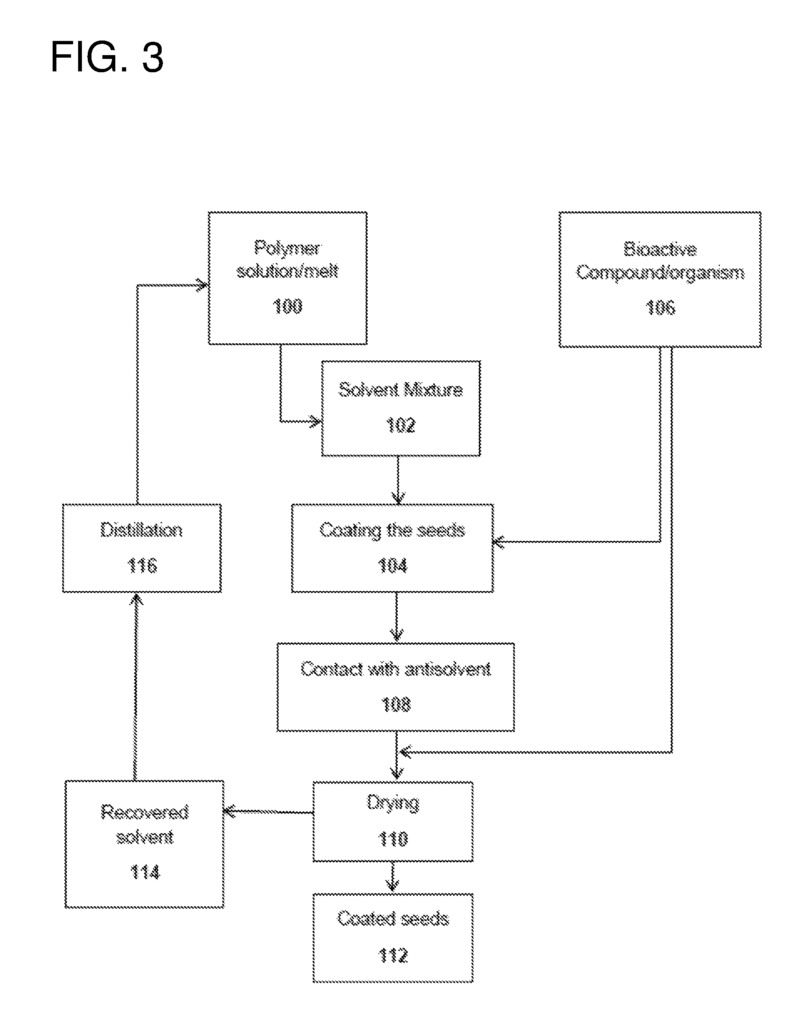
Biostimulants are emerging as a new trend in agriculture. They are formulations containing bioactive metabolites or microorganisms, and they are used to increase the health and productivity of crops. Biostimulants are gaining popularity due to the high costs of developing new chemicals pesticides. Also, there are concerns about insect and weed resistant and increasing regulatory pressures. It is well-established that seed coatings are a good delivery system for agricultural chemical products such as fungicides or insecticides. Redenbaugh, U.S. Patent No. No. No. 4,779 376 (incorporated by reference herein in its entirety), discloses for example a hydrogel formulation which may be used to encapsulate herbicides pesticides insecticides fungicides fumigants repellants rodenticides fertilizers nutrients sugars carbohydrates adenosine Triphosphate microorganisms growth regulators hormones around a seeds. The gel can be made from a variety of materials, including alginate and carrageenan.
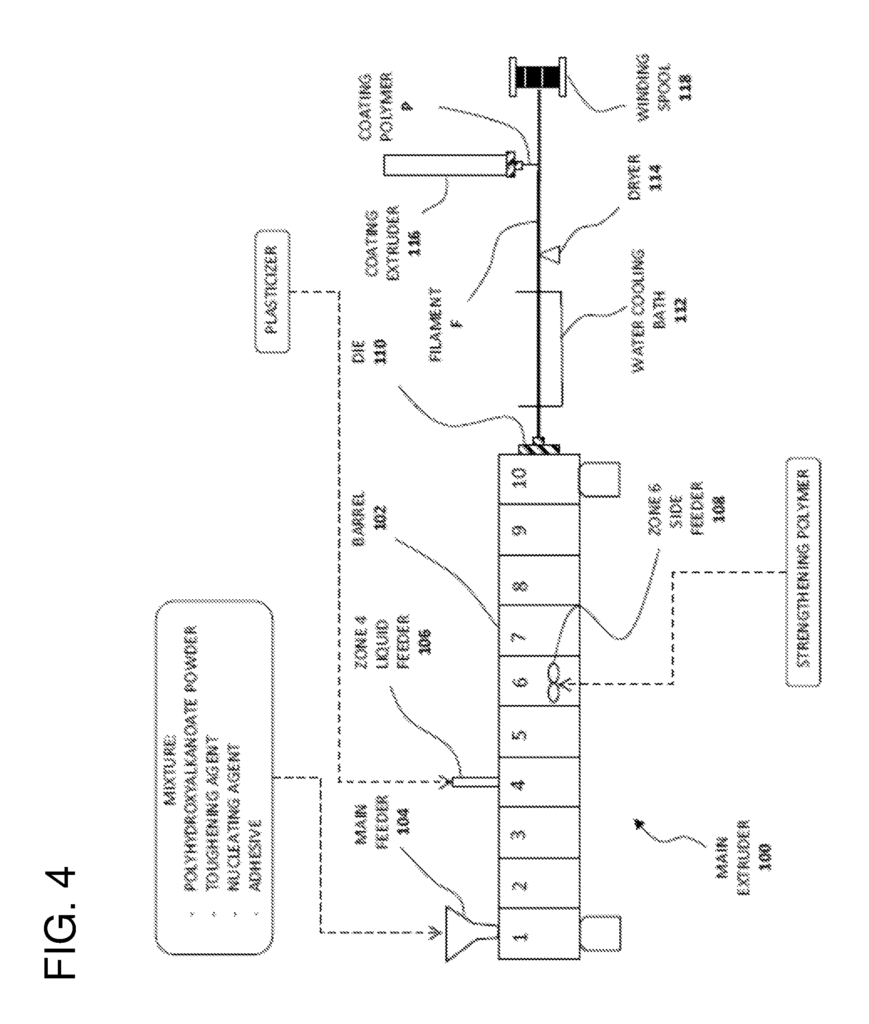
Click here to view the patent on Google Patents.
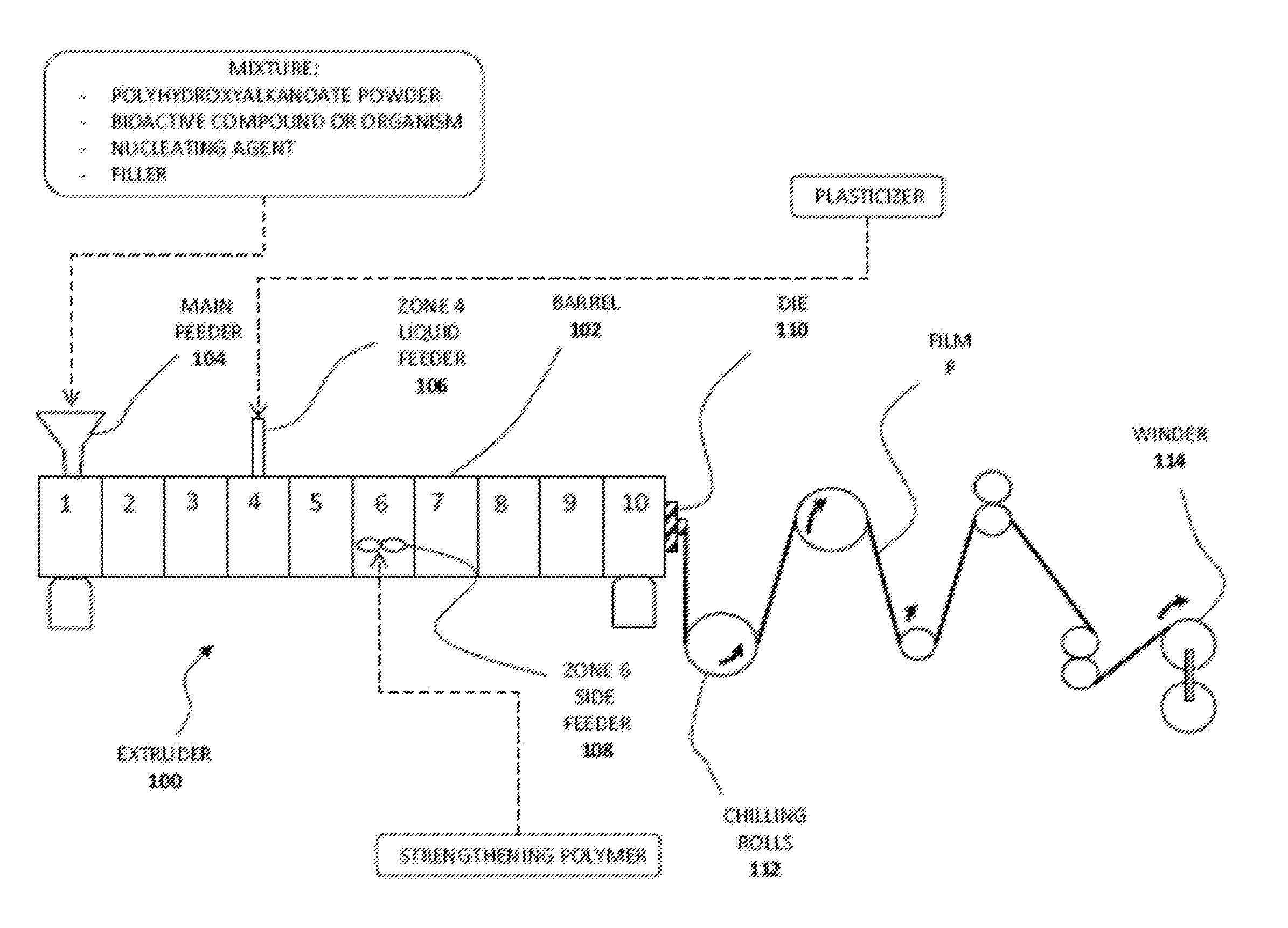
Leave a Reply